Cirrus Logic CS4272 User Manual
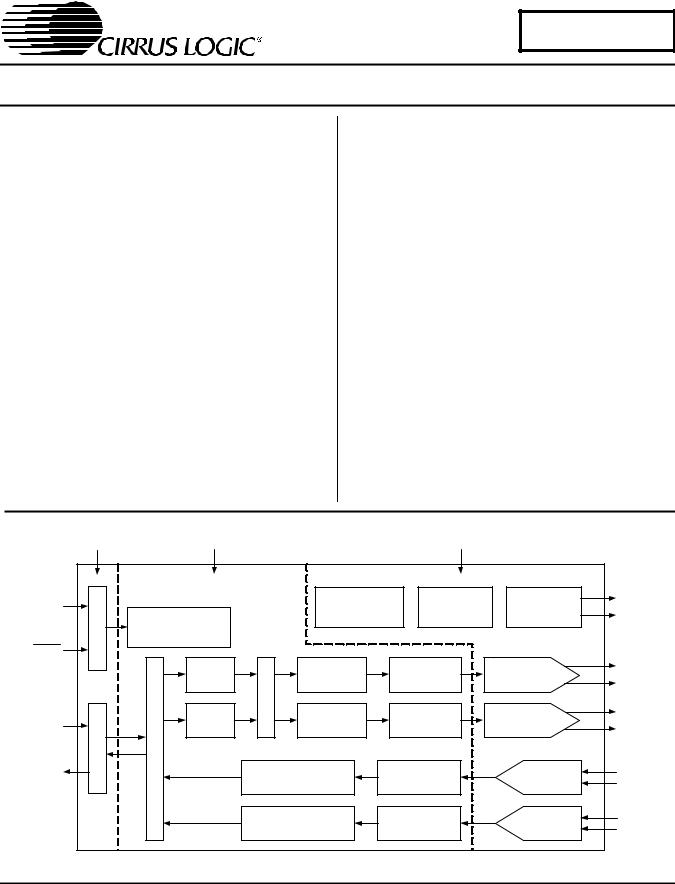
CS4272
24-Bit, 192 kHz Stereo Audio CODEC
D/A Features
!High Performance
–114 dB Dynamic Range
–-100 dB THD+N
!Up to 192 kHz Sampling Rates
!Differential Analog Architecture
!Volume Control with Soft Ramp
–1 dB Step Size
–Zero Crossing Click-free Transitions
!Selectable Digital Filters
–Fast and Slow Roll Off
!ATAPI Mixing Functions
!Selectable Serial Audio Interface Formats
–Left Justified up to 24-bit
–I2S up to 24-bit
–Right Justified 16-, 18-, 20-, and 24-Bit
!Control Output for External Muting
!Selectable 50/15 s De-emphasis
A/D Features
!High Performance
–114 dB Dynamic Range
–-100 dB THD+N
!Up to 192 kHz Sampling Rates
!Differential Analog Architecture
!Multi-bit Delta Sigma Conversion
!High-pass Filter or DC Offset Calibration
!Low-Latency Digital Anti-alias Filtering
!Automatic Dithering of 16-bit Data
!Selectable Serial Audio Interface Formats
–Left Justified up to 24-bit
–I2S up to 24-bit
System Features
!Direct Interface with 5V to 2.5V Logic Levels
!Internal Digital Loopback
!On-chip Oscillator
!Stand-Alone or Control Port Functionality
|
2.5 V to 5 V |
|
3.3 V to 5 V |
|
|
|
5 V |
|
|
Hardware or |
Translator |
|
|
|
Internal Voltage |
Internal |
External |
Left and |
|
I2C/SPI |
|
|
|
Right Mute |
|||||
Control Data |
Register / Hardware |
|
Reference |
|
Oscillator |
Mute Control |
Controls |
||
|
|
|
|
|
|||||
|
Configuration |
|
|
|
|
|
|
||
Reset |
Level |
|
|
|
|
|
|
|
|
|
|
Volume |
|
Selectable |
|
|
Switched Capacitor |
Left |
|
|
|
|
|
|
∆Σ Modulator |
||||
|
|
Serial Interface / Loopback |
|
Interpolation |
|
Differential |
|||
|
|
Control |
|
|
DAC and Filter |
||||
|
|
Mixer |
Filter |
|
|
Output |
|||
|
|
|
|
|
|
||||
Serial |
Level Translator |
Volume |
Selectable |
|
|
Switched Capacitor |
Right |
||
|
|
∆Σ Modulator |
|||||||
|
Interpolation |
|
Differential |
||||||
Audio |
Control |
|
|
DAC and Filter |
|||||
|
Filter |
|
|
Output |
|||||
Input |
|
|
|
|
|
||||
|
|
|
|
|
|
|
|||
Serial |
|
|
|
|
|
Multibit |
Left |
||
Audio |
|
High Pass Filter & |
Low-Latency |
||||||
|
Oversampling |
Differential |
|||||||
Output |
|
DC Offset Calibration |
Anti-Alias Filter |
||||||
|
ADC |
Input |
|||||||
|
|
|
|
|
|
||||
|
|
PCM |
|
High Pass Filter & |
Low-Latency |
Multibit |
Right |
||
|
|
|
|
DC Offset Calibration |
Anti-Alias Filter |
Oversampling |
Differential |
||
|
|
|
|
ADC |
Input |
||||
|
|
|
|
|
|
|
|
||
Cirrus Logic, Inc. |
Copyright ♥ Cirrus Logic, Inc. 2005 |
AUGUST '05 |
www.cirrus.com |
(All Rights Reserved) |
DS593F1 |
|
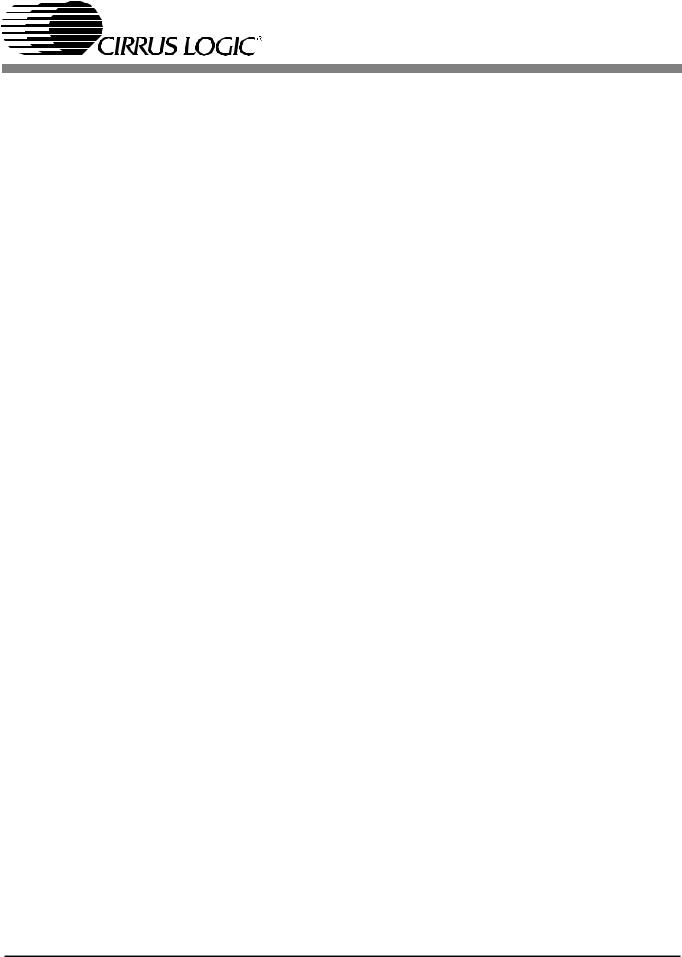
Stand-Alone Mode Feature Set
!System Features
–Serial Audio Port Master or Slave Operation
–Internal Oscillator for Master Clock
!D/A Features
–Auto-mute on Static Samples
–44.1 kHz 50/15 s De-emphasis Available
–Selectable Serial Audio Interface Formats
"Left Justified up to 24-bit "I2S up to 24-bit
!A/D Features
–Automatic Dithering for 16-bit Data
–High-pass Filter
–Selectable Serial Audio Interface Formats
"Left Justified up to 24-bit "I2S up to 24-bit
Software Mode Feature Set
!System Features
–Serial Audio Port Master or Slave Operation
–Internal Oscillator for Master Clock
–Internal Digital Loopback Available
!D/A Features
–Selectable Auto-mute
–Selectable Interpolation Filters
–Selectable 32-, 44.1-, and 48-kHz De-emphasis Filters
–Configurable ATAPI Mixing Functions
–Configurable Volume and Muting Controls
–Selectable Serial Audio Interface Formats
"Left Justified up to 24-bit "I2S up to 24-bit
"Right Justified 16, 18, 20, and 24-bit
!A/D Features
–Selectable Dithering for 16-bit Data
–Selectable High-pass Filter or DC Offset Calibration
–Selectable Serial Audio Interface Formats
"Left Justified up to 24-bit "I2S up to 24-bit
CS4272
General Description
The CS4272 is a high-performance, integrated audio CODEC. The CS4272 performs stereo analog-to-digital (A/D) and digital-to-analog (D/A) conversion of up to 24-bit serial values at sample rates up to 192 kHz.
The D/A offers a volume control that operates with a 1 dB step size. It incorporates selectable soft ramp and zero crossing transition functions to eliminate clicks and pops.
The D/A’s integrated digital mixing functions allow a variety of output configurations ranging from a channel swap to a stereo-to-mono downmix.
Standard 50/15 s de-emphasis is available for sampling rates of 32, 44.1, and 48 kHz for compatibility with digital audio programs mastered using the 50/15 s preemphasis technique.
Integrated level translators allow easy interfacing between the CS4272 and other devices operating over a wide range of logic levels.
An on-chip oscillator eliminates the need for an external crystal oscillator circuit. This can reduce overall design cost and conserve circuit board space. The CS4272 automatically uses the on-chip oscillator in the absence of an applied master clock, making this feature easy to use.
Independently addressable high-pass filters are available for the right and left channel of the A/D. This allows the A/D to be used in a wide variety of applications where one audio channel and one DC measurement channel is desired.
The CS4272’s wide dynamic range, negligible distortion, and low noise make it ideal for applications such as A/V receivers, DVD-R, CD-R, digital mixing consoles, effects processors, set-top box systems, and automotive audio systems.
Ordering Information
Product |
Description |
Package |
Pb-Free |
Grade |
Temp Range |
Container |
Order # |
|
|
|
|
|
Commercial |
-10° to +70° C |
Tube |
CS4272-CZZ |
|
CS4272 |
24-Bit, 192 kHz |
28-pin |
YES |
Tape & Reel |
CS4272-CZZR |
|||
Stereo Audio CODEC |
TSSOP |
Automotive |
-40° to +85° C |
Tube |
CS4272-DZZ |
|||
|
|
|||||||
|
|
|
|
Tape & Reel |
CS4272-DZZR |
|||
CDB4272 |
CS4272 Evaluation Board |
No |
- |
- |
- |
CDB4272 |
||
2 |
DS593F1 |
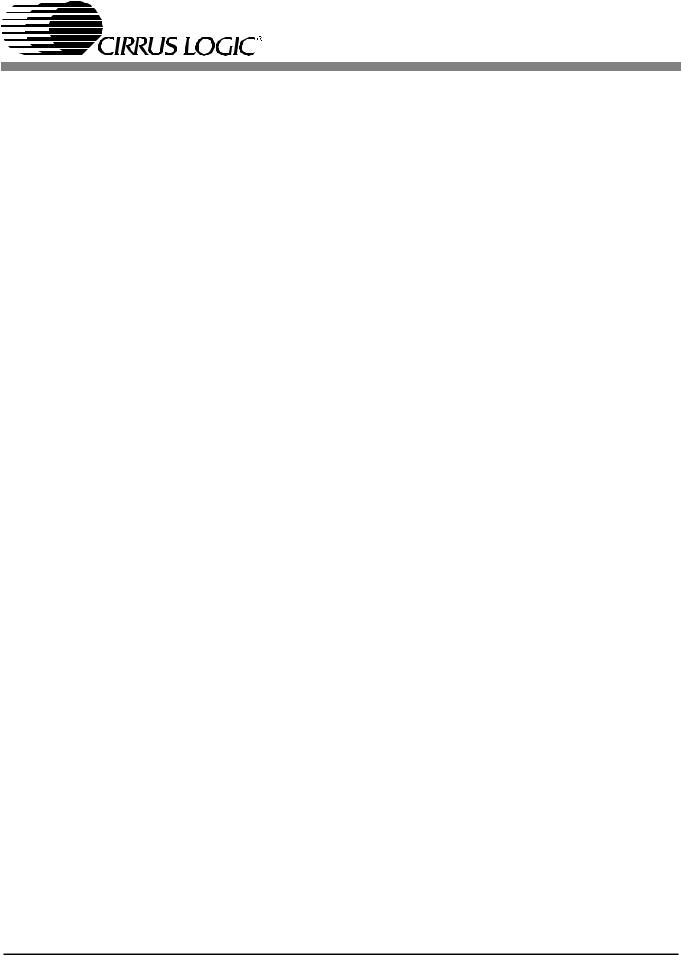
|
CS4272 |
TABLE OF CONTENTS |
|
1. PIN DESCRIPTIONS - SOFTWARE MODE ............................................................................. |
5 |
2. PIN DESCRIPTIONS - STAND-ALONE MODE ....................................................................... |
7 |
3. CHARACTERISTICS AND SPECIFICATIONS ........................................................................ |
9 |
SPECIFIED OPERATING CONDITIONS................................................................................. |
9 |
ABSOLUTE MAXIMUM RATINGS ........................................................................................... |
9 |
DAC ANALOG CHARACTERISTICS - COMMERCIAL GRADE............................................ |
10 |
DAC ANALOG CHARACTERISTICS - AUTOMOTIVE GRADE ............................................ |
11 |
DAC COMBINED INTERPOLATION & ON-CHIP ANALOG FILTER RESPONSE................ |
12 |
ADC ANALOG CHARACTERISTICS - COMMERCIAL GRADE............................................ |
14 |
ADC ANALOG CHARACTERISTICS - AUTOMOTIVE GRADE ............................................ |
15 |
ADC DIGITAL FILTER CHARACTERISTICS......................................................................... |
16 |
DC ELECTRICAL CHARACTERISTICS ................................................................................ |
17 |
DIGITAL CHARACTERISTICS............................................................................................... |
17 |
SWITCHING CHARACTERISTICS - SERIAL AUDIO PORT................................................. |
18 |
SWITCHING CHARACTERISTICS - I²C MODE CONTROL PORT....................................... |
21 |
SWITCHING CHARACTERISTICS - SPI CONTROL PORT ................................................. |
22 |
4. TYPICAL CONNECTION DIAGRAM ..................................................................................... |
23 |
5. APPLICATIONS ..................................................................................................................... |
24 |
5.1 Stand-Alone Mode ........................................................................................................... |
24 |
5.1.1 Recommended Power-Up Sequence ................................................................. |
24 |
5.1.2 Master/Slave Mode ............................................................................................. |
24 |
5.1.3 System Clocking ................................................................................................. |
24 |
5.1.3.1 Crystal Applications (XTI/XTO) ........................................................... |
24 |
5.1.3.2 Clock Ratio Selection .......................................................................... |
25 |
5.1.4 16-Bit Auto-Dither ............................................................................................... |
26 |
5.1.5 Auto-Mute ........................................................................................................... |
26 |
5.1.6 High Pass Filter ................................................................................................... |
26 |
5.1.7 Interpolation Filter .............................................................................................. |
26 |
5.1.8 Mode Selection & De-Emphasis ......................................................................... |
26 |
5.1.9 Serial Audio Interface Format Selection ............................................................. |
26 |
5.2 Control Port Mode ........................................................................................................... |
27 |
5.2.1 Recommended Power-Up Sequence - Access to Control Port Mode ................ |
27 |
5.2.2 Master / Slave Mode Selection ........................................................................... |
27 |
5.2.3 System Clocking ................................................................................................. |
27 |
5.2.3.1 Crystal Applications (XTI/XTO) ........................................................... |
27 |
5.2.3.2 Clock Ratio Selection .......................................................................... |
28 |
5.2.4 Internal Digital Loopback .................................................................................... |
30 |
5.2.5 Dither for 16-Bit Data .......................................................................................... |
30 |
5.2.6 Auto-Mute ........................................................................................................... |
30 |
5.2.7 High Pass Filter and DC Offset Calibration ......................................................... |
30 |
5.2.8 Interpolation Filter .............................................................................................. |
31 |
5.2.9 De-Emphasis ...................................................................................................... |
31 |
5.2.10 Oversampling Modes ........................................................................................ |
31 |
5.3 De-Emphasis Filter .......................................................................................................... |
31 |
5.4 Analog Connections ........................................................................................................ |
32 |
5.4.1 Input Connections ............................................................................................... |
32 |
5.4.2 Output Connections ............................................................................................ |
33 |
5.5 Mute Control .................................................................................................................... |
34 |
5.6 Synchronization of Multiple Devices ................................................................................ |
34 |
5.7 Grounding and Power Supply Decoupling ....................................................................... |
34 |
6. CONTROL PORT INTERFACE .............................................................................................. |
35 |
DS593F1 |
3 |
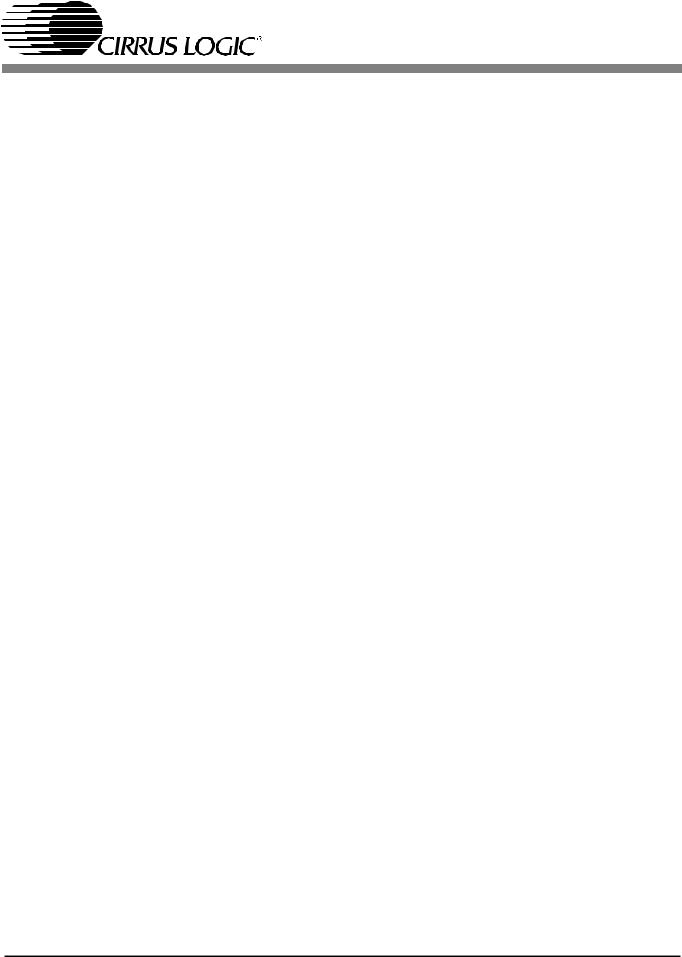
|
|
CS4272 |
6.1 |
SPI Mode ......................................................................................................................... |
35 |
6.2 |
I²C Mode .......................................................................................................................... |
36 |
7. REGISTER QUICK REFERENCE .......................................................................................... |
37 |
|
8. REGISTER DESCRIPTION .................................................................................................... |
38 |
|
8.1 |
Mode Control 1 - Address 01h ......................................................................................... |
38 |
|
8.1.1 Functional Mode (Bits 7:6) .................................................................................. |
38 |
|
8.1.2 Ratio Select (Bits 5:4) ......................................................................................... |
38 |
|
8.1.3 Master / Slave Mode (Bit 3) ................................................................................. |
38 |
|
8.1.4 DAC Digital Interface Format (Bits 2:0) ............................................................... |
38 |
8.2 |
DAC Control - Address 02h ............................................................................................. |
39 |
|
8.2.1 Auto-Mute (Bit 7) ................................................................................................. |
39 |
|
8.2.2 Interpolation Filter Select (Bit 6) .......................................................................... |
39 |
|
8.2.3 De-Emphasis Control (Bits 5:4) ........................................................................... |
39 |
|
8.2.4 Soft Volume Ramp-Up After Error (Bit 3) ............................................................ |
40 |
|
8.2.5 Soft Ramp-Down Before Filter Mode Change (Bit 2) .......................................... |
40 |
|
8.2.6 Invert Signal Polarity (Bits 1:0) ............................................................................ |
40 |
8.3 |
DAC Volume & Mixing Control - Address 03h ................................................................. |
40 |
|
8.3.1 Channel B Volume = Channel A Volume (Bit 6) ................................................. |
40 |
|
8.3.2 Soft Ramp or Zero Cross Enable (Bits 5:4) ......................................................... |
40 |
|
8.3.3 ATAPI Channel Mixing and Muting (Bits 3:0) ...................................................... |
41 |
8.4 |
DAC Channel A Volume Control - Address 04h .............................................................. |
42 |
8.5 |
DAC Channel B Volume Control - Address 05h .............................................................. |
42 |
|
8.5.1 Mute (Bit 7) .......................................................................................................... |
42 |
|
8.5.2 Volume Control (Bits 6:0) .................................................................................... |
42 |
8.6 |
ADC Control - Address 06h ............................................................................................. |
43 |
|
8.6.1 Dither for 16-Bit Data (Bit 5) ................................................................................ |
43 |
|
8.6.2 ADC Digital Interface Format (Bit 4) .................................................................... |
43 |
|
8.6.3 ADC Channel A & B Mute (Bits 3:2) .................................................................... |
43 |
|
8.6.4 Channel A & B High Pass Filter Disable (Bits 1:0) .............................................. |
43 |
8.7 |
Mode Control 2 - Address 07h ......................................................................................... |
43 |
|
8.7.1 Digital Loopback (Bit 4) ....................................................................................... |
43 |
|
8.7.2 AMUTEC = BMUTEC (Bit 3) ............................................................................... |
43 |
|
8.7.3 Freeze (Bit 2) ...................................................................................................... |
44 |
|
8.7.4 Control Port Enable (Bit 1) .................................................................................. |
44 |
|
8.7.5 Power Down (Bit 0) ............................................................................................. |
44 |
8.8 |
Chip ID - Register 08h ..................................................................................................... |
44 |
|
8.8.1 Chip ID (Bits 7:4) ................................................................................................. |
44 |
|
8.8.2 Chip Revision (Bits 3:0) ....................................................................................... |
44 |
9. PARAMETER DEFINITIONS .................................................................................................. |
45 |
|
10. PACKAGE DIMENSIONS ..................................................................................................... |
46 |
|
11. APPENDIX ............................................................................................................................ |
47 |
|
4 |
DS593F1 |
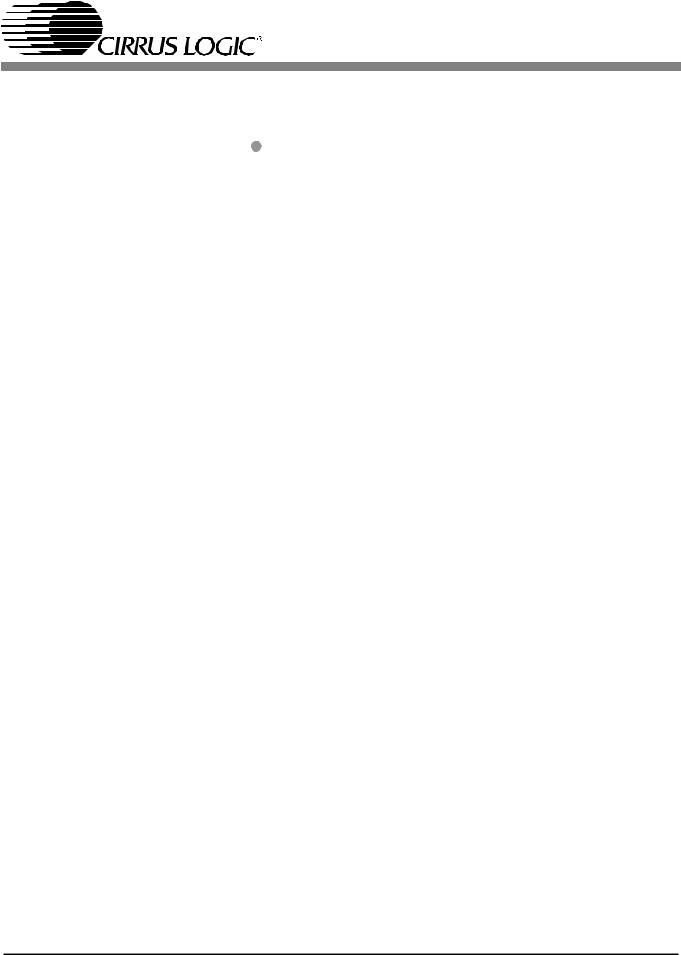
CS4272
1.PIN DESCRIPTIONS - SOFTWARE MODE
|
|
|
|
|
|
|
|
|
|
|
|
|
|
|
|
XTO |
|
|
|
1 |
28 |
|
|
|
|
BMUTEC |
|||||
|
|
|
|
|
|
|
|
||||||||
|
XTI |
|
|
|
|
2 |
27 |
|
|
|
|
AOUTB- |
|||
|
|
|
|
|
|
|
|
|
|||||||
MCLK |
|
|
|
|
3 |
26 |
|
|
|
|
AOUTB+ |
||||
|
|
|
|
|
|
|
|
||||||||
LRCK |
|
|
|
|
4 |
25 |
|
|
|
|
AOUTA+ |
||||
|
|
|
|
|
|
|
|
||||||||
SCLK |
|
|
|
|
5 |
24 |
|
|
|
|
AOUTA- |
||||
|
|
|
|
|
|
|
|
||||||||
SDOUT |
|
|
|
|
|
|
|
|
|
|
|
|
|||
|
|
|
6 |
23 |
|
|
|
|
AMUTEC |
|
|||||
|
|
|
|
|
|
|
|
|
|||||||
SDIN |
|
|
|
|
7 |
28-Pin TSSOP 22 |
|
|
|
|
FILT+ |
||||
|
|
|
|
|
|
|
|
||||||||
DGND |
|
|
|
|
8 |
21 |
|
|
|
AGND |
|||||
|
|
|
|
|
|
|
|||||||||
|
|
VD |
|
|
|
|
9 |
20 |
|
|
|
|
VA |
||
|
|
|
|
|
|
|
|
|
|
||||||
|
|
VL |
|
|
|
|
10 |
19 |
|
|
|
|
AINB- |
||
|
|
|
|
|
|
|
|
|
|
||||||
SCL/CCLK |
|
|
|
11 |
18 |
|
|
|
|
AINB+ |
|||||
|
|
|
|
|
|
|
|
||||||||
SDA/CDIN |
|
|
|
|
12 |
17 |
|
|
|
|
AINA+ |
||||
|
|
|
|
|
|
|
|
||||||||
|
|
|
|
|
|
|
|
||||||||
|
|
|
|
|
|
|
|
|
|
|
|
|
|
|
|
AD0/CS |
|
|
|
|
13 |
16 |
|
|
|
|
AINA- |
||||
|
|
|
|
|
|
|
|
|
|||||||
|
|
|
|
|
|
|
|
|
|
|
|
|
|
VCOM |
|
|
RST |
|
|
|
|
14 |
15 |
|
|
|
|
||||
|
|
|
|
|
|
|
|
|
|
||||||
|
|
|
|
|
|
|
|
|
|
||||||
DS593F1 |
5 |
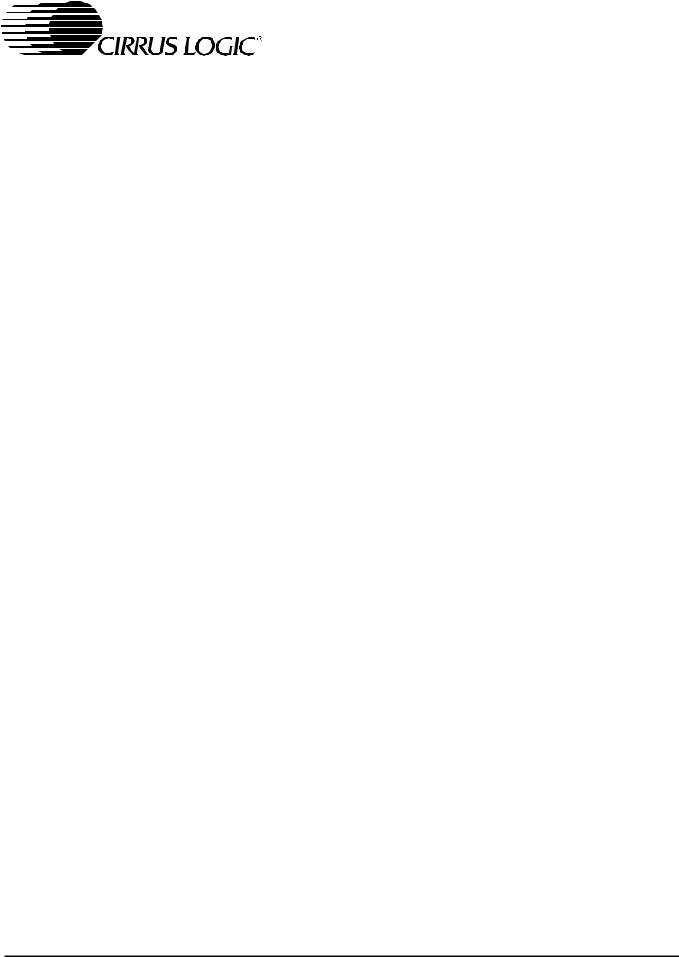
CS4272
|
|
|
|
|
|
|
|
|
|
|
|
|
|
|
|
|
|
|
|
|
|
|
|
|
|
Pin Name |
# |
Pin Description |
|||||||
|
|
|
|
|
|
||||||
|
|
XTO |
1,2 |
Crystal Connections (Input/Output) - I/O pins for an external crystal which may be used to generate |
|||||||
|
|
XTI |
|
MCLK. See “Crystal Applications (XTI/XTO)” on page 24 or “Crystal Applications (XTI/XTO)” on page 27. |
|
||||||
|
|
MCLK |
3 |
Master Clock (Input/Output) -Clock source for the delta-sigma modulators. See “Crystal Applications |
|||||||
|
|
(XTI/XTO)” on page 24 or “Crystal Applications (XTI/XTO)” on page 27. |
|||||||||
|
|
|
|
|
|
|
|
||||
|
|
|
|
|
|
|
|
|
|
||
|
|
LRCK |
4 |
Left Right Clock (Input/Output) - Determines which channel, Left or Right, is currently active on the |
|||||||
|
|
serial audio data line. |
|||||||||
|
|
|
|
|
|
|
|
||||
|
|
|
|
|
|
||||||
|
|
SCLK |
5 |
Serial Clock (Input/Output) - Serial clock for the serial audio interface. |
|||||||
|
|
|
|
|
|
||||||
|
|
SDOUT |
6 |
Serial Audio Data Output (Output) - Output for two’s complement serial audio data. |
|||||||
|
|
|
|
|
|
||||||
|
|
SDIN |
7 |
Serial Audio Data Input (Input) - Input for two’s complement serial audio data. |
|||||||
|
|
|
|
|
|
||||||
|
|
DGND |
8 |
Digital Ground (Input) - Ground reference for the internal digital section. |
|||||||
|
|
|
|
|
|
||||||
|
|
VD |
9 |
Digital Power (Input) - Positive power for the internal digital section. |
|||||||
|
|
|
|
|
|
||||||
|
|
VL |
10 |
Logic Power (Input) - Positive power for the digital input/output interface. |
|||||||
|
|
|
|
|
|
||||||
|
|
SCL/CCLK |
11 |
Serial Control Port Clock (Input) - Serial clock for the serial control port. |
|||||||
|
|
|
|
|
|
|
|
|
|
||
|
|
SDA/CDIN |
12 |
Serial Control Data (Input/Output) - SDA is a data I/O in I²C mode. CDIN is the input data line for the |
|||||||
|
|
control port interface in SPI mode. |
|||||||||
|
|
|
|
|
|
|
|
||||
|
|
|
|
|
|
|
|
|
|
|
|
|
|
|
|
|
|
|
|
Address Bit 0 (I²C) / Control Port Chip Select (SPI) (Input) - AD0 is a chip address pin in I²C mode; |
|
|
|
|
|
|
|
|
|
|
13 |
CS |
|||
|
|
AD0/CS |
|||||||||
|
|
is the chip select signal for SPI format. |
|||||||||
|
|
|
|
|
|
|
|
||||
|
|
|
|
|
|
|
|||||
|
|
|
|
|
|
|
14 |
Reset (Input) - The device enters a low power mode when this pin is driven low. |
|||
|
|
RST |
|
|
|||||||
|
|
|
|
|
|
||||||
|
|
VCOM |
15 |
Common Mode Voltage (Output) - Filter connection for internal common mode voltage. |
|||||||
|
|
|
|
|
|
|
|
||||
|
|
AINA- |
16, |
|
|
|
|
||||
|
|
AINA+ |
17, |
Differential Analog Input (Input) - The full scale differential input signals are presented to the delta- |
|||||||
|
|
AINB+ |
18, |
sigma modulators. The full scale level is specified in the ADC Analog Characteristics specification table. |
|||||||
|
|
AINB- |
19 |
|
|
|
|
||||
|
|
|
|
|
|
||||||
|
|
VA |
20 |
Analog Power (Input) - Positive power for the internal analog section. |
|||||||
|
|
|
|
|
|
||||||
|
|
AGND |
21 |
Analog Ground (Input) - Ground reference for the internal analog section. |
|||||||
|
|
|
|
|
|
||||||
|
|
FILT+ |
22 |
Positive Voltage Reference (Output) - Positive reference voltage for the internal sampling circuits. |
|||||||
|
|
|
|
|
|
|
|
|
|
||
|
|
|
|
|
|
|
23 |
Channel A Mute Control (Output) - This pin is active during power-up initialization, reset, muting, when |
|||
|
|
AMUTEC |
|||||||||
|
|
master clock to left/right clock frequency ratio is incorrect, or power-down. |
|||||||||
|
|
|
|
|
|
|
|
||||
|
|
|
|
|
|
|
|
||||
|
|
AOUTA- |
24, |
|
|
|
|
||||
|
|
AOUTA+ |
25, |
Differential Analog Audio Output (Output) - The full scale differential output level is specified in the |
|||||||
|
|
AOUTB+ |
26, |
DAC Analog Characteristics specification table. |
|||||||
|
|
AOUTB- |
27 |
|
|
|
|
||||
|
|
|
|
|
|
|
|
|
|
||
|
|
|
|
|
|
|
28 |
Channel B Mute Control (Output) - This pin is active during power-up initialization, reset, muting, when |
|||
|
|
BMUTEC |
|||||||||
|
|
master clock to left/right clock frequency ratio is incorrect, or power-down. |
|||||||||
|
|
|
|
|
|
|
|
||||
|
|
|
|
|
|
|
|
|
|
|
|
6 |
DS593F1 |
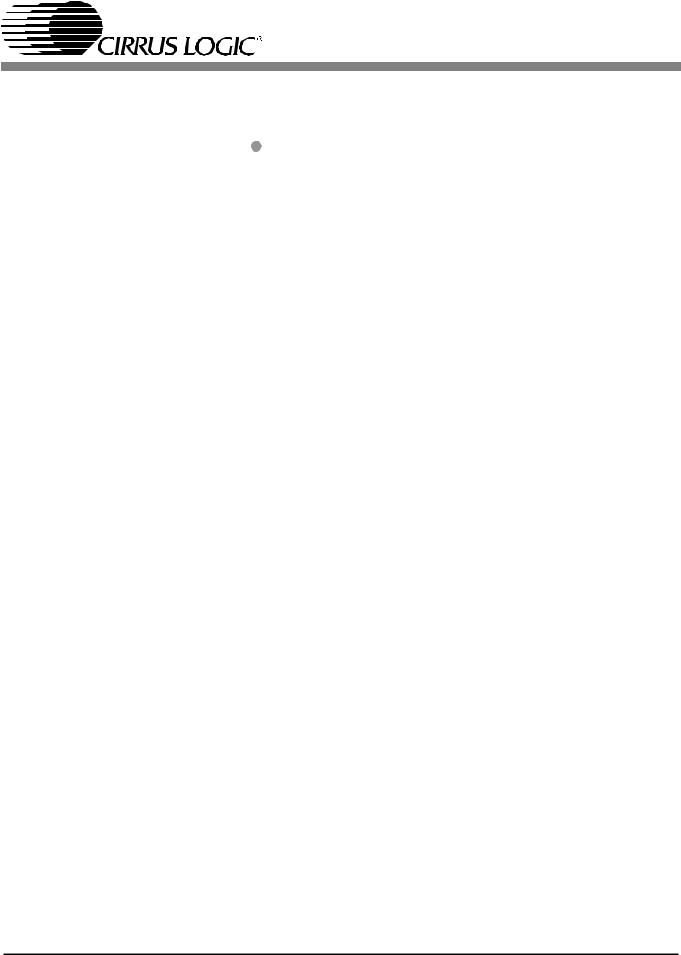
CS4272
2.PIN DESCRIPTIONS - STAND-ALONE MODE
|
|
|
|
|
|
|
|
|
|
|
|
|
|
|
|
|
XTO |
|
|
|
1 |
28 |
|
|
|
|
BMUTEC |
||||||
|
|
|
|
|
|
|
|
|||||||||
|
XTI |
|
|
|
|
2 |
27 |
|
|
|
|
AOUTB- |
||||
|
|
|
|
|
|
|
|
|
||||||||
MCLK |
|
|
|
|
3 |
26 |
|
|
|
|
AOUTB+ |
|||||
|
|
|
|
|
|
|
|
|||||||||
LRCK |
|
|
|
|
4 |
25 |
|
|
|
|
AOUTA+ |
|||||
|
|
|
|
|
|
|
|
|||||||||
SCLK |
|
|
|
|
5 |
24 |
|
|
|
|
AOUTA- |
|||||
|
|
|
|
|
|
|
|
|||||||||
|
|
|
|
|
|
|
|
|
|
|
|
|
|
|
|
|
SDOUT (M/S) |
|
|
|
|
|
6 |
23 |
|
|
|
|
AMUTEC |
||||
|
|
|
|
|
|
|
|
|
|
|||||||
SDIN |
|
|
|
|
7 |
28-Pin TSSOP 22 |
|
|
|
|
FILT+ |
|||||
|
|
|
|
|
|
|
|
|||||||||
DGND |
|
|
|
|
8 |
21 |
|
|
|
AGND |
||||||
|
|
|
|
|
|
|
||||||||||
|
VD |
|
|
|
|
9 |
20 |
|
|
|
|
VA |
||||
|
|
|
|
|
|
|
|
|
||||||||
|
VL |
|
|
|
|
10 |
19 |
|
|
|
|
AINB- |
||||
|
|
|
|
|
|
|
|
|
||||||||
|
M0 |
|
|
|
11 |
18 |
|
|
|
AINB+ |
||||||
|
|
|
|
|
|
|
|
|||||||||
|
M1 |
|
|
|
|
12 |
17 |
|
|
|
AINA+ |
|||||
|
|
|
|
|
|
|
|
|||||||||
|
|
|
|
|
|
|
|
|||||||||
|
|
|
|
|
|
|
|
|
|
|
|
|
|
AINA- |
||
I2S/LJ |
|
|
|
|
13 |
16 |
|
|
|
|
||||||
|
|
|
|
|
|
|
|
|
||||||||
|
|
|
|
|
|
|
|
|
|
|
|
|
|
|
|
VCOM |
|
RST |
|
|
|
|
14 |
15 |
|
|
|
|
|||||
|
|
|
|
|
|
|
|
|
|
|||||||
|
|
|
|
|
|
|
|
|
|
|||||||
DS593F1 |
7 |

CS4272
|
|
|
|
|
|
|
|
|
|
|
|
|
|
|
|
|
|
|
|
|
|
Pin Name |
# |
Pin Description |
|||||
|
|
|
|
|
|
|
|
|
|
|
|
XTO |
1,2 |
Crystal Connections (Input/Output) - I/O pins for an external crystal which may be used to generate the |
|||||
|
|
master clock. See “Crystal Applications (XTI/XTO)” on page 24 or “Crystal Applications (XTI/XTO)” on |
|||||||
|
|
XTI |
|||||||
|
|
|
page 27. |
||||||
|
|
|
|
|
|
|
|
||
|
|
|
|
|
|
|
|
|
|
|
|
MCLK |
3 |
Master Clock (Input/Output) -Clock source for the delta-sigma modulators. See “Crystal Applications |
|||||
|
|
(XTI/XTO)” on page 24 or “Crystal Applications (XTI/XTO)” on page 27. |
|||||||
|
|
|
|
|
|
|
|
||
|
|
|
|
|
|
|
|
|
|
|
|
LRCK |
4 |
Left Right Clock (Input/Output) - Determines which channel, Left or Right, is currently active on the |
|||||
|
|
serial audio data line. |
|||||||
|
|
|
|
|
|
|
|
||
|
|
|
|
|
|
||||
|
|
SCLK |
5 |
Serial Clock (Input/Output) - Serial clock for the serial audio interface. |
|||||
|
|
|
|
|
|
||||
|
|
SDOUT |
6 |
Serial Audio Data Output (Output) - Output for two’s complement serial audio data. This pin must be |
|||||
|
|
(M/S) |
pulled-up or pulled-down to select Master or Slave Mode. See “Master/Slave Mode” on page 24. |
|
|||||
|
|
|
|||||||
|
|
SDIN |
7 |
Serial Audio Data Input (Input) - Input for two’s complement serial audio data. |
|||||
|
|
|
|
|
|
||||
|
|
DGND |
8 |
Digital Ground (Input) - Ground reference for the internal digital section. |
|||||
|
|
|
|
|
|
||||
|
|
VD |
9 |
Digital Power (Input) - Positive power for the internal digital section. |
|||||
|
|
|
|
|
|
||||
|
|
VL |
10 |
Logic Power (Input) - Positive power for the digital input/output interface. |
|||||
|
|
|
|
|
|
|
|
|
|
|
|
M0 |
11 |
Mode Select 0 (Input) - In conjunction with M1, selects operating mode. Functionality is described in the |
|||||
|
|
Hardware Mode Speed Configuration table. |
|||||||
|
|
|
|
|
|
|
|
||
|
|
|
|
|
|
|
|
|
|
|
|
M1 |
12 |
Mode Select 1 (Input) - In conjunction with M0, selects operating mode. Functionality is described in the |
|||||
|
|
Hardware Mode Speed Configuration table. |
|||||||
|
|
|
|
|
|
|
|
||
|
|
|
|
|
|
|
|
|
|
|
|
|
|
|
|
|
13 |
Serial Audio Interface Select (Input) - Selects either the left-justified or I2S format for the Serial Audio |
|
|
|
I2S/LJ |
|||||||
|
|
Interface. |
|||||||
|
|
|
|
|
|
|
|
||
|
|
|
|
|
|
|
|||
|
|
|
|
|
|
|
14 |
Reset (Input) - The device enters a low power mode when this pin is driven low. |
|
|
|
RST |
|
|
|||||
|
|
|
|
|
|
||||
|
|
VCOM |
15 |
Common Mode Voltage (Output) - Filter connection for internal common mode voltage. |
|||||
|
|
|
|
|
|
||||
|
|
AINA- |
16, |
|
|
||||
|
|
AINA+ |
17, |
Differential Analog Input (Input) - The full scale differential input signals are presented to the delta- |
|||||
|
|
AINB+ |
18, |
sigma modulators. The full scale level is specified in the ADC Analog Characteristics specification table. |
|||||
|
|
AINB- |
19 |
|
|
||||
|
|
|
|
|
|
||||
|
|
VA |
20 |
Analog Power (Input) - Positive power for the internal analog section. |
|||||
|
|
|
|
|
|
||||
|
|
AGND |
21 |
Analog Ground (Input) - Ground reference for the internal analog section. |
|||||
|
|
|
|
|
|
||||
|
|
FILT+ |
22 |
Positive Voltage Reference (Output) - Positive reference voltage for the internal sampling circuits. |
|||||
|
|
|
|
|
|
|
|
|
|
|
|
|
|
|
|
|
23 |
Channel A Mute Control (Output) - This pin is active during power-up initialization, reset, muting, when |
|
|
|
AMUTEC |
|||||||
|
|
master clock to left/right clock frequency ratio is incorrect, or power-down. |
|||||||
|
|
|
|
|
|
|
|
||
|
|
|
|
|
|
||||
|
|
AOUTA- |
24, |
|
|
||||
|
|
AOUTA+ |
25, |
Differential Analog Audio Output (Output) - The full scale differential output level is specified in the |
|||||
|
|
AOUTB+ |
26, |
Analog Characteristics specification table. |
|||||
|
|
AOUTB- |
27 |
|
|
||||
|
|
|
|
|
|
|
|
|
|
|
|
|
|
|
|
|
28 |
Channel B Mute Control (Output) - This pin is active during power-up initialization, reset, muting, when |
|
|
|
BMUTEC |
|||||||
|
|
master clock to left/right clock frequency ratio is incorrect, or power-down. |
|||||||
|
|
|
|
|
|
|
|
||
|
|
|
|
|
|
|
|
|
|
8 |
DS593F1 |
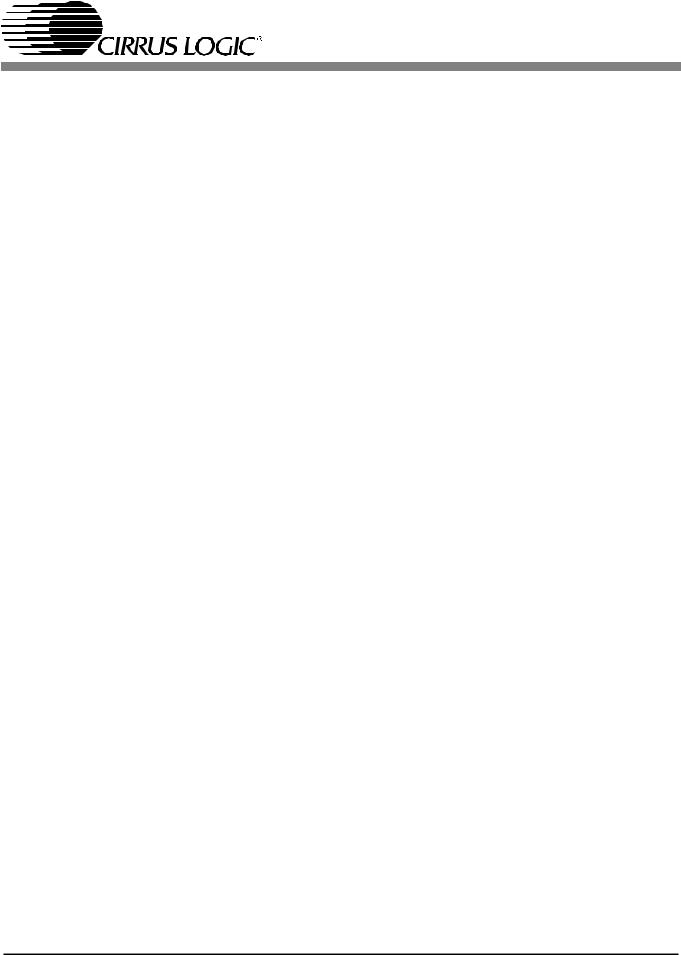
CS4272
3.CHARACTERISTICS AND SPECIFICATIONS
(All Min/Max characteristics and specifications are guaranteed over the Specified Operating Conditions. Typical performance characteristics and specifications are derived from measurements taken at nominal supply voltages and TA = 25°C.)
SPECIFIED OPERATING CONDITIONS (AGND = 0 V; all voltages with respect to ground.)
|
Parameters |
Symbol |
Min |
Nom |
Max |
Units |
DC Power Supplies: |
Positive Analog |
VA |
4.75 |
5.0 |
5.25 |
V |
|
Positive Digital |
VD |
3.1 |
3.3 |
5.25 |
V |
|
Positive Logic |
VL |
2.37 |
3.3 |
5.25 |
V |
Ambient Operating Temperature (Power Applied) |
|
|
|
|
°C |
|
|
Commercial Grade |
TA |
-10 |
- |
+70 |
|
|
Automotive Grade |
|
-40 |
- |
+85 |
°C |
ABSOLUTE MAXIMUM RATINGS (GND = 0 V, All voltages with respect to ground.) (Note 1)
Parameter |
|
Symbol |
Min |
Typ |
Max |
Units |
|
|
|
|
|
|
|
DC Power Supplies: |
Analog |
VA |
-0.3 |
- |
+6.0 |
V |
|
Logic |
VL |
-0.3 |
- |
+6.0 |
V |
|
Digital |
VD |
-0.3 |
- |
+6.0 |
V |
|
|
|
|
|
|
|
Input Current |
(Note 2) |
Iin |
- |
- |
±10 |
mA |
Analog Input Voltage |
|
VIN |
GND-0.3 |
- |
VA+0.3 |
V |
Digital Input Voltage |
|
VIND |
-0.3 |
- |
VL+0.3 |
V |
Ambient Operating Temperature (Power Applied) |
|
TA |
-50 |
- |
+95 |
°C |
Storage Temperature |
|
Tstg |
-65 |
- |
+150 |
°C |
Notes: 1. Operation beyond these limits may result in permanent damage to the device. Normal operation is not guaranteed at these extremes.
2.Any pin except supplies. Transient currents of up to ±100 mA on the analog input pins will not cause SCR latch-up.
DS593F1 |
9 |
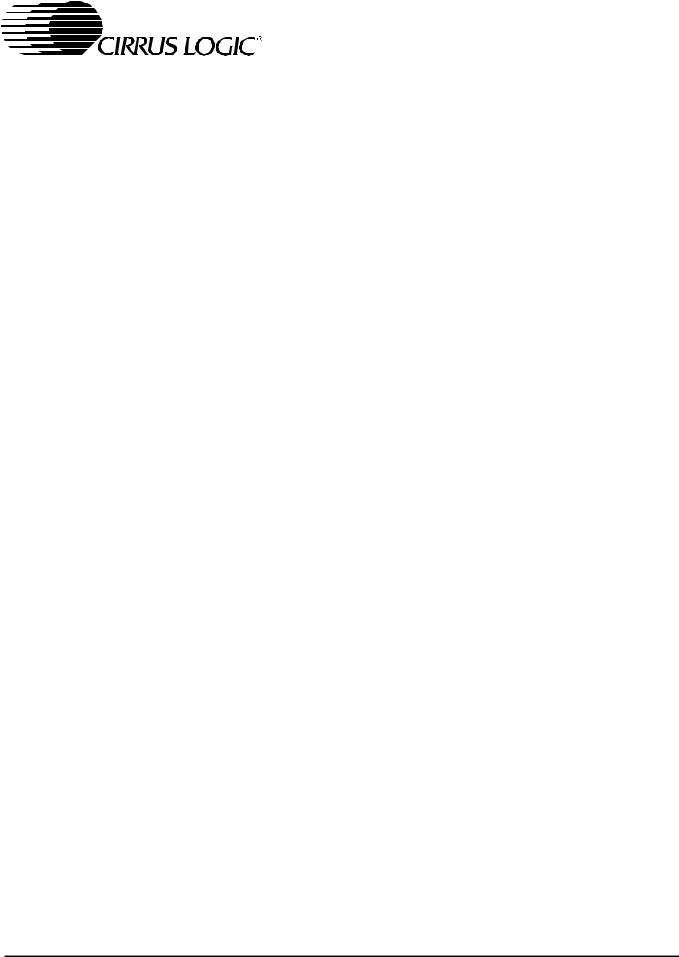
|
|
|
|
|
|
|
|
CS4272 |
||
|
|
|
|
|
|
|||||
|
|
|
|
|
|
|||||
|
DAC ANALOG CHARACTERISTICS - COMMERCIAL GRADE (Notes 3 to 7) |
|||||||||
|
|
|
|
|
|
|
|
|
|
|
|
Parameter |
|
Symbol |
Min |
Typ |
Max |
|
Unit |
|
|
|
Dynamic Performance |
|
|
|
|
|
|
|
|
|
|
Dynamic Range |
24-Bits |
A-Weighted |
|
108 |
114 |
- |
|
dB |
|
|
|
|
unweighted |
|
105 |
111 |
- |
|
dB |
|
|
|
16-Bits |
unweighted |
|
- |
94 |
- |
|
dB |
|
|
Total Harmonic Distortion + Noise |
0 dB |
THD+N |
- |
-100 |
-94 |
|
dB |
|
|
|
|
|
-20 dB |
|
- |
-91 |
- |
|
dB |
|
|
|
|
-60 dB |
|
- |
-51 |
-45 |
|
dB |
|
|
Idle Channel Noise / Signal-to-Noise Ratio |
|
|
- |
114 |
- |
|
dB |
|
|
|
Interchannel Isolation |
|
(1 kHz) |
|
- |
100 |
- |
|
dB |
|
|
DC Accuracy |
|
|
|
|
|
|
|
|
|
|
Interchannel Gain Mismatch |
|
|
ICGM |
- |
0.1 |
- |
|
dB |
|
|
Gain Drift |
|
|
|
- |
100 |
- |
|
ppm/°C |
|
|
Analog Output Characteristics and Specifications |
|
|
|
|
|
|
|
||
|
Full Scale Differential Output Voltage |
|
VFS |
0.91xVA |
0.96xVA |
1.01xVA |
|
Vpp |
|
|
|
Output Resistance |
|
(note 7) |
Zout |
- |
100 |
- |
|
Ω |
|
|
Minimum AC-Load Resistance |
|
RL |
- |
3 |
- |
|
kΩ |
|
|
|
Maximum Load Capacitance |
|
|
CL |
- |
100 |
- |
|
pF |
|
Notes: 3. One-half LSB of Triangular PDF dither is added to data.
4.Performance measurements taken with a full-scale 997 Hz sine wave under Test load RL = 3 kΩ, CL = 10 pF
5.Measurement bandwidth is 10 Hz to 20 kHz.
6.Logic “0” = GND = 0V; Logic “1” = VL; VL = VA unless otherwise noted.
7.VFS is tested under load RL but does not include attenuation due to ZOUT
10 |
DS593F1 |
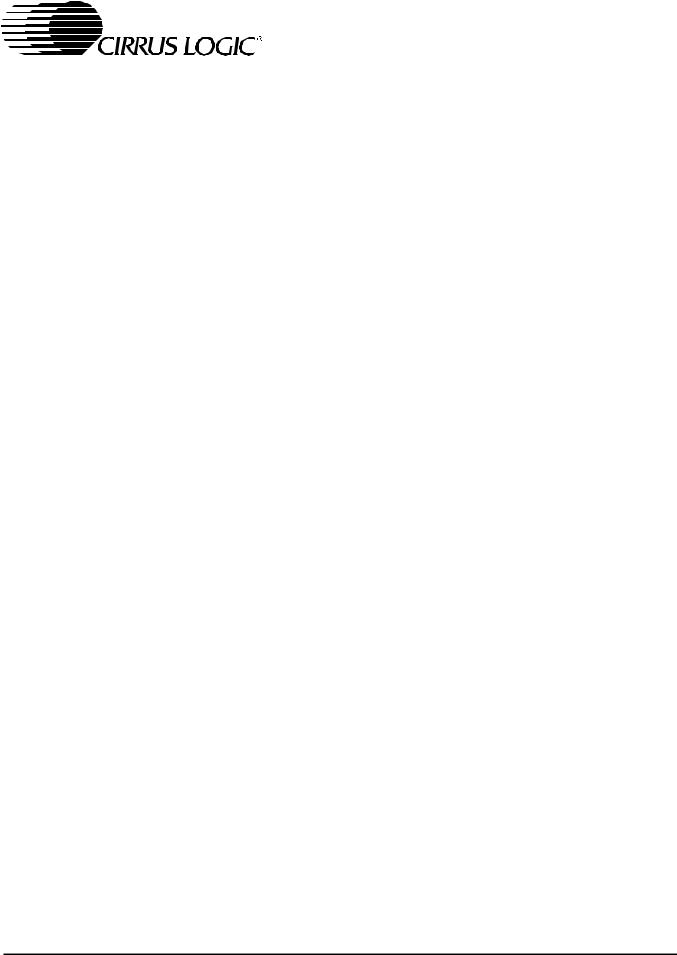
|
|
|
|
|
|
|
|
CS4272 |
||
|
|
|
|
|
|
|||||
|
|
|
|
|
|
|||||
|
DAC ANALOG CHARACTERISTICS - AUTOMOTIVE GRADE (Notes 3 to 7) |
|||||||||
|
|
|
|
|
|
|
|
|
|
|
|
Parameter |
|
Symbol |
Min |
Typ |
Max |
|
Unit |
|
|
|
Dynamic Performance |
|
|
|
|
|
|
|
|
|
|
Dynamic Range |
24-Bits |
A-Weighted |
|
106 |
114 |
- |
|
dB |
|
|
|
|
unweighted |
|
103 |
111 |
- |
|
dB |
|
|
|
16-Bits |
unweighted |
|
- |
94 |
- |
|
dB |
|
|
Total Harmonic Distortion + Noise |
0 dB |
THD+N |
- |
-100 |
-92 |
|
dB |
|
|
|
|
|
-20 dB |
|
- |
-91 |
- |
|
dB |
|
|
|
|
-60 dB |
|
- |
-51 |
-43 |
|
dB |
|
|
Idle Channel Noise / Signal-to-Noise Ratio |
|
|
- |
114 |
- |
|
dB |
|
|
|
Interchannel Isolation |
|
(1 kHz) |
|
- |
100 |
- |
|
dB |
|
|
DC Accuracy |
|
|
|
|
|
|
|
|
|
|
Interchannel Gain Mismatch |
|
|
ICGM |
- |
0.1 |
- |
|
dB |
|
|
Gain Drift |
|
|
|
- |
100 |
- |
|
ppm/°C |
|
|
Analog Output Characteristics and Specifications |
|
|
|
|
|
|
|
||
|
Full Scale Differential Output Voltage |
|
VFS |
0.91xVA |
0.96xVA |
1.01xVA |
|
Vpp |
|
|
|
Output Resistance |
|
(note 7) |
Zout |
- |
100 |
- |
|
Ω |
|
|
Minimum AC-Load Resistance |
|
RL |
- |
3 |
- |
|
kΩ |
|
|
|
Maximum Load Capacitance |
|
|
CL |
- |
100 |
- |
|
pF |
|
DS593F1 |
11 |
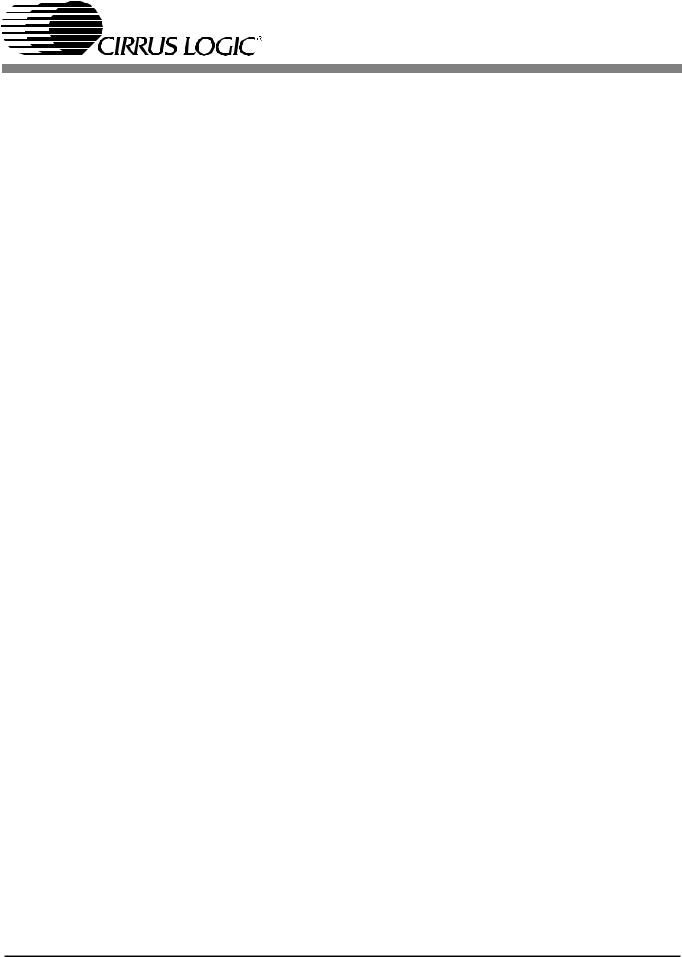
CS4272
DAC COMBINED INTERPOLATION & ON-CHIP ANALOG FILTER RESPONSE
(Note 12)
|
|
|
Fast Roll-Off |
|
|
Parameter |
|
Min |
Typ |
Max |
Unit |
Single Speed Mode - 48 kHz |
|
|
|
|
|
Passband (Note 9) |
to -0.01 dB corner |
0 |
- |
.454 |
Fs |
|
to -3 dB corner |
0 |
- |
.499 |
Fs |
Frequency Response 10 Hz to 20 kHz |
|
-0.01 |
- |
+0.01 |
dB |
StopBand |
|
.547 |
- |
- |
Fs |
StopBand Attenuation |
(Note 10) |
90 |
- |
- |
dB |
Group Delay |
|
- |
12/Fs |
- |
s |
De-emphasis Error (Note 11) |
Fs = 32 kHz |
- |
- |
±0.23 |
dB |
(Relative to 1kHz) |
Fs = 44.1 kHz |
- |
- |
±0.14 |
dB |
|
Fs = 48 kHz |
- |
- |
±0.09 |
dB |
Double Speed Mode - 96 kHz |
|
|
|
|
|
Passband (Note 9) |
to -0.01 dB corner |
0 |
- |
.430 |
Fs |
|
to -3 dB corner |
0 |
- |
.499 |
Fs |
Frequency Response 10 Hz to 20 kHz |
|
-0.01 |
- |
0.01 |
dB |
StopBand |
|
.583 |
- |
- |
Fs |
StopBand Attenuation |
(Note 10) |
80 |
- |
- |
dB |
Group Delay |
|
- |
4.6/Fs |
- |
s |
Quad Speed Mode - 192 kHz |
|
|
|
|
|
Passband (Note 9) |
to -0.01 dB corner |
0 |
- |
.105 |
Fs |
|
to -3 dB corner |
0 |
- |
.490 |
Fs |
Frequency Response 10 Hz to 20 kHz |
|
-0.01 |
- |
0.01 |
dB |
StopBand |
|
.635 |
- |
- |
Fs |
StopBand Attenuation |
(Note 10) |
90 |
- |
- |
dB |
Group Delay |
|
- |
4.7/Fs |
- |
s |
12 |
DS593F1 |
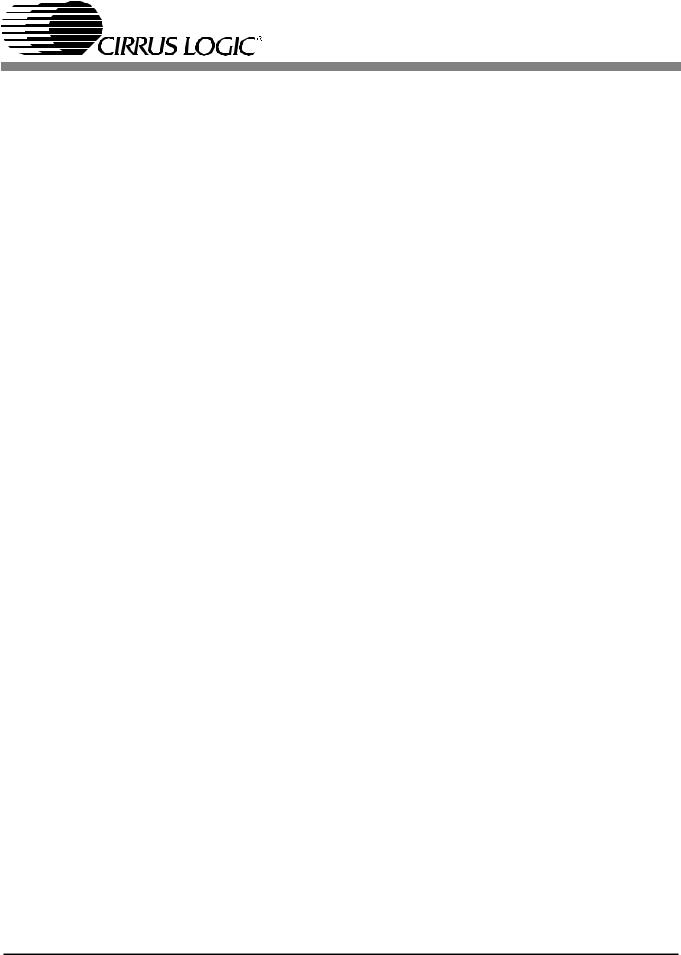
CS4272
DAC COMBINED INTERPOLATION & ON-CHIP ANALOG FILTER RESPONSE
(cont) (Note 12)
|
|
Slow Roll-Off (Note 8) |
|
||
Parameter |
|
Min |
Typ |
Max |
Unit |
Single Speed Mode - 48 kHz |
|
|
|
|
|
Passband (Note 9) |
to -0.01 dB corner |
0 |
- |
0.417 |
Fs |
|
to -3 dB corner |
0 |
- |
0.499 |
Fs |
Frequency Response 10 Hz to 20 kHz |
|
-0.01 |
- |
+0.01 |
dB |
StopBand |
|
.583 |
- |
- |
Fs |
StopBand Attenuation |
(Note 10) |
64 |
- |
- |
dB |
Group Delay |
|
- |
6.5/Fs |
- |
s |
De-emphasis Error (Note 11) |
Fs = 32 kHz |
- |
- |
±0.23 |
dB |
(Relative to 1 kHz) |
Fs = 44.1 kHz |
- |
- |
±0.14 |
dB |
|
Fs = 48 kHz |
- |
- |
±0.09 |
dB |
Double Speed Mode - 96 kHz |
|
|
|
|
|
Passband (Note 9) |
to -0.01 dB corner |
0 |
- |
.296 |
Fs |
|
to -3 dB corner |
0 |
- |
.499 |
Fs |
Frequency Response 10 Hz to 20 kHz |
|
-0.01 |
- |
0.01 |
dB |
StopBand |
|
.792 |
- |
- |
Fs |
StopBand Attenuation |
(Note 10) |
70 |
- |
- |
dB |
Group Delay |
|
- |
3.9/Fs |
- |
s |
Quad Speed Mode - 192 kHz |
|
|
|
|
|
Passband (Note 9) |
to -0.01 dB corner |
0 |
- |
.104 |
Fs |
|
to -3 dB corner |
0 |
- |
.481 |
Fs |
Frequency Response 10 Hz to 20 kHz |
|
-0.01 |
- |
0.01 |
dB |
StopBand |
|
.868 |
- |
- |
Fs |
StopBand Attenuation |
(Note 10) |
75 |
- |
- |
dB |
Group Delay |
|
- |
4.2/Fs |
- |
s |
Notes: 8. Slow Roll-Off interpolation filter is only available in control port mode.
9.Response is clock dependent and will scale with Fs. Note that the response plots (Figures 21 to 44) have been normalized to Fs and can be de-normalized by multiplying the X-axis scale by Fs.
10.Single and Double Speed Mode Measurement Bandwidth is from stopband to 3 Fs. Quad Speed Mode Measurement Bandwidth is from stopband to 1.34 Fs.
11.De-emphasis is available only in Single Speed Mode; Only 44.1 kHz De-emphasis is available in StandAlone Mode.
12.Plots of this data are contained in the “Appendix” on page 47. See Figure 21 through Figure 44.
DS593F1 |
13 |
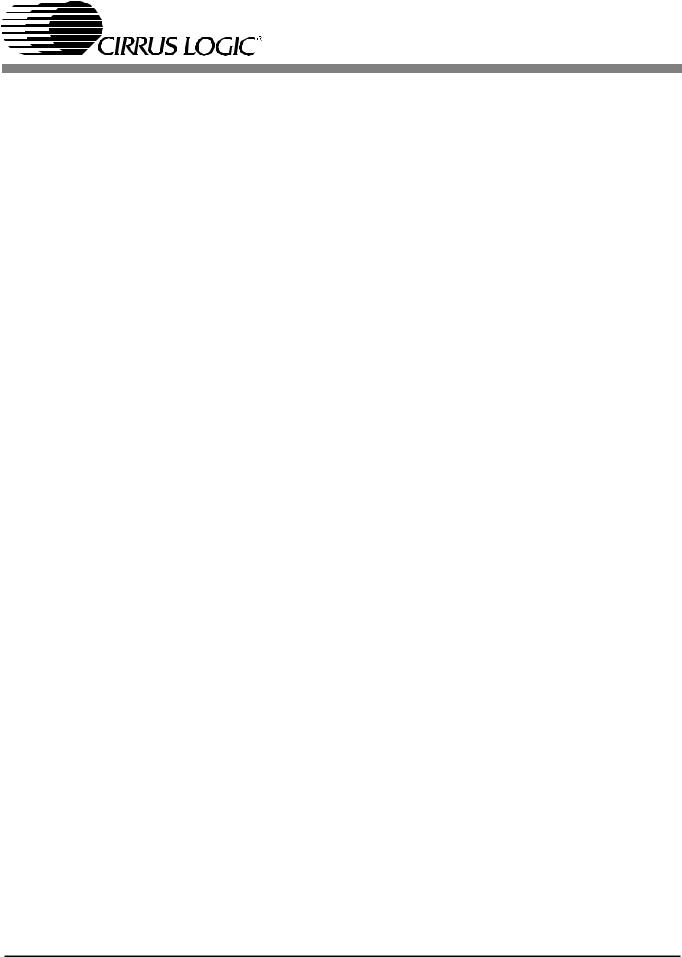
CS4272
ADC ANALOG CHARACTERISTICS - COMMERCIAL GRADE
Measurement Bandwidth is 10 Hz to 20 kHz unless otherwise specified. Input is 1 kHz sine wave.
Parameter |
|
|
Symbol |
Min |
Typ |
Max |
Unit |
Single Speed Mode |
Fs = 48 kHz |
|
|
|
|
|
|
Dynamic Range |
|
A-weighted |
|
108 |
114 |
- |
dB |
|
|
unweighted |
|
105 |
111 |
- |
dB |
Total Harmonic Distortion + Noise |
(Note 13) |
THD+N |
- |
-100 |
-94 |
dB |
|
|
|
-1 dB |
|
||||
|
|
-20 dB |
|
- |
-91 |
- |
dB |
|
|
-60 dB |
|
- |
-51 |
- |
dB |
Double Speed Mode |
Fs = 96 kHz |
|
|
|
|
|
|
Dynamic Range |
|
A-weighted |
|
108 |
114 |
- |
dB |
|
|
unweighted |
|
105 |
111 |
- |
dB |
40 kHz bandwidth unweighted |
|
- |
108 |
- |
dB |
||
Total Harmonic Distortion + Noise |
(Note 13) |
THD+N |
- |
-100 |
-94 |
dB |
|
|
|
-1 dB |
|
||||
|
|
-20 dB |
|
- |
-91 |
- |
dB |
|
|
-60 dB |
|
- |
-51 |
- |
dB |
40 kHz bandwidth |
-1 dB |
|
- |
-97 |
- |
dB |
|
Quad Speed Mode |
Fs = 192 kHz |
|
|
|
|
|
|
Dynamic Range |
|
A-weighted |
|
108 |
114 |
- |
dB |
|
|
unweighted |
|
105 |
111 |
- |
dB |
40 kHz bandwidth unweighted |
|
- |
108 |
- |
dB |
||
Total Harmonic Distortion + Noise |
(Note 13) |
THD+N |
- |
-100 |
-94 |
dB |
|
|
|
-1 dB |
|
||||
|
|
-20 dB |
|
- |
-91 |
- |
dB |
|
|
-60 dB |
|
- |
-51 |
- |
dB |
40 kHz bandwidth |
-1 dB |
|
- |
-97 |
- |
dB |
|
Dynamic Performance for All Modes |
|
|
|
|
|
|
|
Interchannel Isolation |
|
|
|
- |
110 |
- |
dB |
Interchannel Phase Deviation |
|
|
|
- |
0.0001 |
- |
Degree |
DC Accuracy |
|
|
|
|
|
|
|
Interchannel Gain Mismatch |
|
|
|
- |
0.1 |
- |
dB |
Gain Error |
|
|
|
|
- |
±5 |
% |
Gain Drift |
|
|
|
- |
±100 |
- |
ppm/°C |
Offset Error |
HPF enabled |
|
- |
0 |
- |
LSB |
|
|
HPF disabled |
|
- |
100 |
- |
LSB |
|
Analog Input Characteristics |
|
|
|
|
|
|
|
Full-scale Input Voltage |
|
|
|
1.07xVA |
1.13xVA |
1.19xVA |
Vpp |
Input Impedance (Differential) |
|
(Note 14) |
|
37 |
- |
- |
kΩ |
Common Mode Rejection Ratio |
|
|
CMRR |
- |
82 |
- |
dB |
Notes: 13. Referred to the typical full-scale input voltage.
Notes: 14. Measured between AIN+ and AIN-
14 |
DS593F1 |
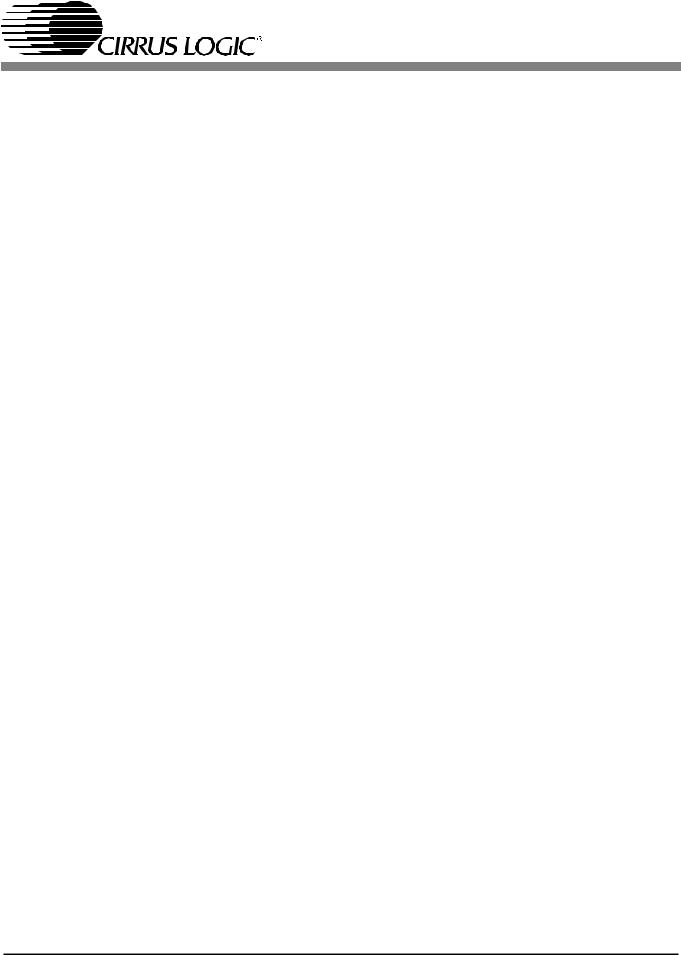
CS4272
ADC ANALOG CHARACTERISTICS - AUTOMOTIVE GRADE
Measurement Bandwidth is 10 Hz to 20 kHz unless otherwise specified. Input is 1 kHz sine wave.)
Parameter |
|
|
Symbol |
Min |
Typ |
Max |
Unit |
Single Speed Mode |
Fs = 48 kHz |
|
|
|
|
|
|
Dynamic Range |
|
A-weighted |
|
106 |
114 |
- |
dB |
|
|
unweighted |
|
103 |
111 |
- |
dB |
Total Harmonic Distortion + Noise |
(Note 15) |
THD+N |
- |
-100 |
-92 |
dB |
|
|
|
-1 dB |
|
||||
|
|
-20 dB |
|
- |
-91 |
- |
dB |
|
|
-60 dB |
|
- |
-51 |
- |
dB |
Double Speed Mode |
Fs = 96 kHz |
|
|
|
|
|
|
Dynamic Range |
|
A-weighted |
|
106 |
114 |
- |
dB |
|
|
unweighted |
|
103 |
111 |
- |
dB |
40 kHz bandwidth unweighted |
|
- |
108 |
- |
dB |
||
Total Harmonic Distortion + Noise |
(Note 15) |
THD+N |
- |
-100 |
-92 |
dB |
|
|
|
-1 dB |
|
||||
|
|
-20 dB |
|
- |
-91 |
- |
dB |
|
|
-60 dB |
|
- |
-51 |
- |
dB |
40 kHz bandwidth |
-1 dB |
|
- |
-97 |
- |
dB |
|
Quad Speed Mode |
Fs = 192 kHz |
|
|
|
|
|
|
Dynamic Range |
|
A-weighted |
|
106 |
114 |
- |
dB |
|
|
unweighted |
|
103 |
111 |
- |
dB |
40 kHz bandwidth unweighted |
|
- |
108 |
- |
dB |
||
Total Harmonic Distortion + Noise |
(Note 15) |
THD+N |
- |
-100 |
-92 |
dB |
|
|
|
-1 dB |
|
||||
|
|
-20 dB |
|
- |
-91 |
- |
dB |
|
|
-60 dB |
|
- |
-51 |
- |
dB |
40 kHz bandwidth |
-1 dB |
|
- |
-97 |
- |
dB |
|
Dynamic Performance for All Modes |
|
|
|
|
|
|
|
Interchannel Isolation |
|
|
|
- |
110 |
- |
dB |
Interchannel Phase Deviation |
|
|
|
- |
0.0001 |
- |
Degree |
DC Accuracy |
|
|
|
|
|
|
|
Interchannel Gain Mismatch |
|
|
|
- |
0.1 |
- |
dB |
Gain Error |
|
|
|
|
- |
±5 |
% |
Gain Drift |
|
|
|
- |
±100 |
- |
ppm/°C |
Offset Error |
HPF enabled |
|
- |
0 |
- |
LSB |
|
|
HPF disabled |
|
- |
100 |
- |
LSB |
|
Analog Input Characteristics |
|
|
|
|
|
|
|
Full-scale Input Voltage |
|
|
|
1.07xVA |
1.13xVA |
1.19xVA |
Vpp |
Input Impedance (Differential) |
|
(Note 16) |
|
37 |
- |
- |
kΩ |
Common Mode Rejection Ratio |
|
|
CMRR |
- |
82 |
- |
dB |
Notes: 15. Referred to the typical full-scale input voltage.
Notes: 16. Measured between AIN+ and AIN-
DS593F1 |
15 |
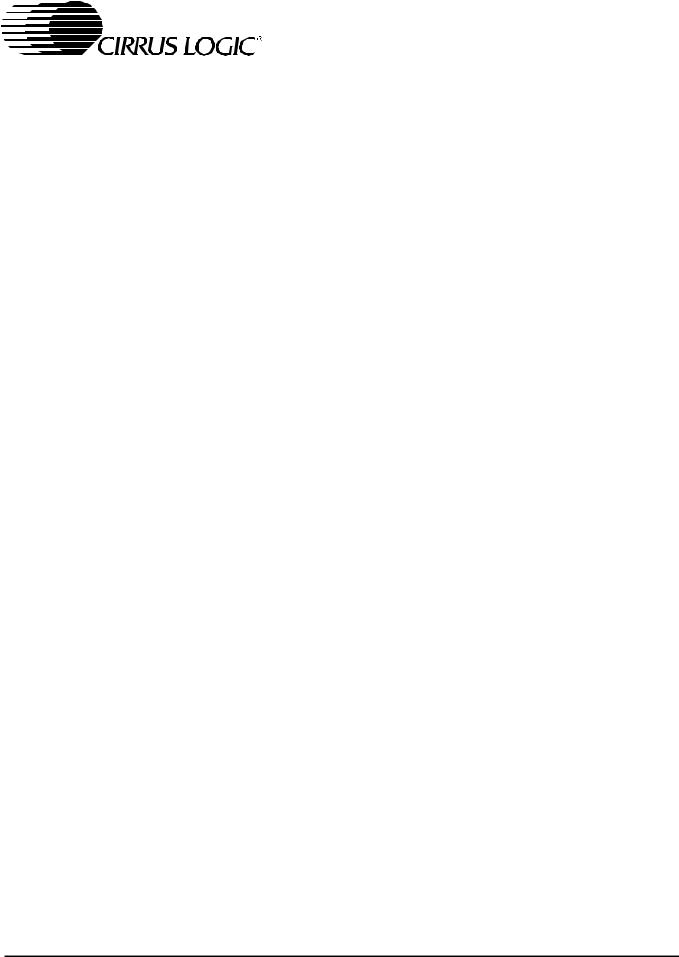
CS4272
|
|
|
|
|
|
|
|
|
|
|
|
ADC DIGITAL FILTER CHARACTERISTICS |
(Note 19) |
|
|
|
|
|
|||
|
|
|
|
|
|
|
|
|
|
|
|
|
Parameter |
|
|
Symbol |
Min |
Typ |
Max |
Unit |
|
|
Single Speed Mode |
|
|
|
|
|
|
|
|
|
|
Passband |
(-0.1 dB). |
(Note 17) |
|
0 |
- |
0.47 |
Fs |
|
|
|
Passband Ripple. |
|
|
|
|
- |
- |
±0.035 |
dB |
|
|
Stopband. |
|
(Note 17) |
|
0.58 |
- |
- |
Fs |
|
|
|
Stopband Attenuation. |
|
|
|
|
-95 |
- |
- |
dB |
|
|
Group Delay. |
|
|
|
tgd |
- |
12/Fs |
- |
s |
|
|
Double Speed Mode |
|
|
|
|
|
|
|
|
|
|
Passband |
(-0.1 dB). |
(Note 17) |
|
0 |
- |
0.45 |
Fs |
|
|
|
Passband Ripple. |
|
|
|
|
- |
- |
±0.035 |
dB |
|
|
Stopband. |
|
(Note 17) |
|
0.68 |
- |
- |
Fs |
|
|
|
Stopband Attenuation. |
|
|
|
|
-92 |
- |
- |
dB |
|
|
Group Delay. |
|
|
|
tgd |
- |
9/Fs |
- |
s |
|
|
Quad Speed Mode |
|
|
|
|
|
|
|
|
|
|
Passband |
(-0.1 dB). |
(Note 17) |
|
0 |
- |
0.24 |
Fs |
|
|
|
Passband Ripple. |
|
|
|
|
- |
- |
±0.035 |
dB |
|
|
Stopband. |
|
(Note 17) |
|
0.78 |
- |
- |
Fs |
|
|
|
Stopband Attenuation. |
|
|
|
|
-97 |
- |
- |
dB |
|
|
Group Delay. |
|
|
|
tgd |
- |
5/Fs |
- |
s |
|
|
High Pass Filter Characteristics |
|
|
|
|
|
|
|
|
|
|
Frequency Response |
-3.0 dB. |
|
|
|
- |
1 |
- |
Hz |
|
|
|
-0.13 dB. |
(Note 18) |
|
|
20 |
- |
Hz |
|
|
|
Phase Deviation |
@ 20 Hz. |
(Note 18) |
|
- |
10 |
- |
Deg |
|
|
|
Passband Ripple. |
|
|
|
|
- |
- |
0 |
dB |
|
|
Filter Settling Time. |
|
|
|
|
|
105/Fs |
|
s |
|
Notes: 17. The filter frequency response scales precisely with Fs.
18.Response shown is for Fs equal to 48 kHz. Filter characteristics scale with Fs.
19.Plots of this data are contained in the “Appendix” on page 47. See Figure 45 through Figure 56.
16 |
DS593F1 |
